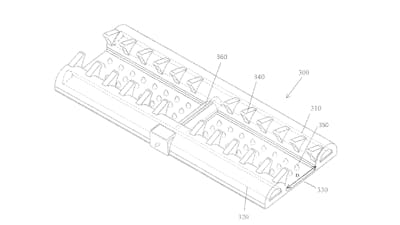Innovations in DNA origami-mediated nucleic acid sequencing, surgical devices, high-throughput analysis of molecular structures, and fluidic device design
To realize its overarching goal to invent and commercialize disruptive solutions for healthcare, energy, architecture, robotics, and manufacturing, the Wyss Institute is creating a patent portfolio in relevant areas that are or can become an essential basis for specific business development and commercialization efforts. To learn more about these innovations, contact our Business Development Team.
The Wyss Institute’s U.S. patents issued between January and March 2018 are as follows:

Spatial sequencing of nucleic acids using DNA origami probes
U.S. Patent 9,914,967 (March 13, 2018)
George M. Church, Richard C. Terry, and Frederic Vigneault
Abstract: A method of sequencing nucleic acids by probe hybridization and/or ligation is provided using DNA origami as a barcode for a nucleic acid probe.
Soft retractors
U.S. Patent 9,907,545 (March 6, 2018)
Kevin C. Galloway and Joshua Aaron Lessing
Abstract: A soft material retractor includes at least two soft actuators, each actuator having at least one pressurizable interior space, wherein the actuator has a first flexible resting state and a second stiffer pressurized state; and a flexible sheet spanning the actuators such that the actuators can be spaced apart from each other by a distance selected to displace a volume of material of a body cavity. The retractor can be uses for holding open wounds or incisions, with trochars, or to displace anatomical features such as organs within a body cavity.

High-Throughput Structure Determination Using Nucleic Acid Calipers
U.S. Patent 9,897,597 (February 20,2018)
William M. Shih and Wesley Philip Wong
Abstract: Provided herein are compositions and methods for determining the structure of individual targets using nucleic acid caliper by determining long-range distances within such targets.
Microfluidic cartridge assembly
U.S. Patent 9,855,554 (January 2, 2018)
Donald E. Ingber, Daniel Levner, Guy Thompson II, and Christopher David Hinojosa
Abstract: According to aspects of the present invention, a cartridge assembly for transporting fluid into or out of one or more fluidic devices includes a first layer and a second layer. The first layer includes a first surface. The first surface includes at least one partial channel disposed thereon. The second layer abuts the first surface, thereby forming a channel from the at least one partial channel. At least one of the first layer and the second layer is a resilient layer formed from a pliable material. At least one of the first layer and the second layer includes a via hole. The via hole is aligned with the channel to pass fluid thereto. The via hole is configured to pass fluid through the first layer or the second layer substantially perpendicularly to the channel. Embossments are also used to define aspects of a fluidic channel.
